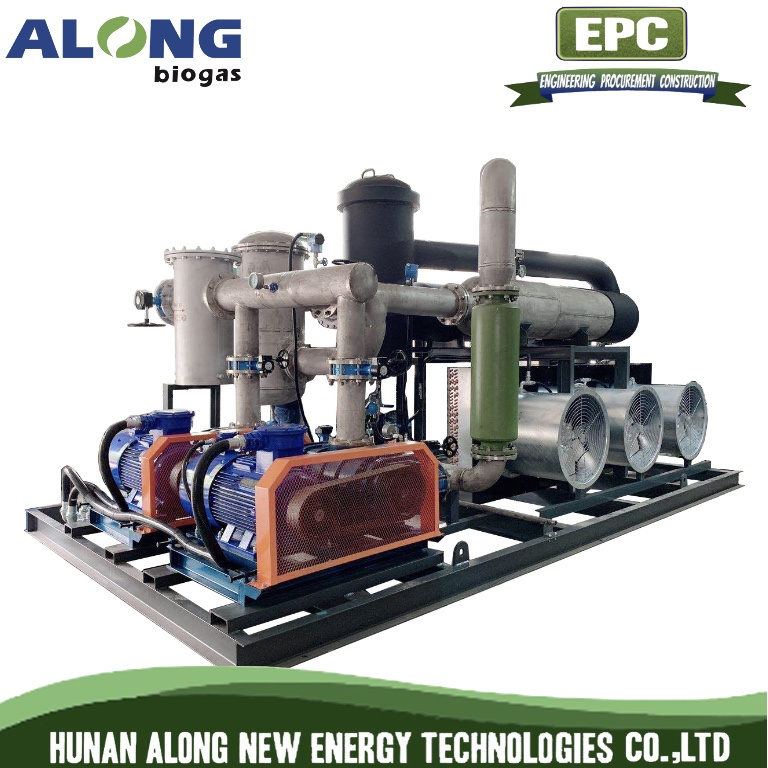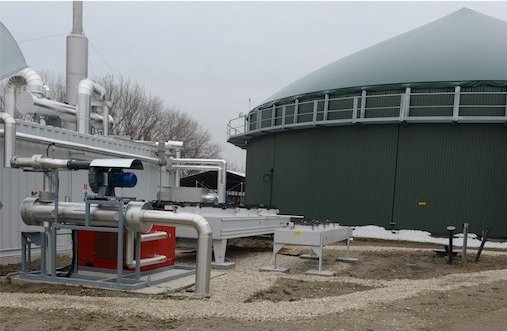The Most Effective Biogas Dehumidifier Options
Key Takeaways
- Biogas dehumidifiers improve the quality and energy efficiency of biogas by removing moisture content.
- Key components of a biogas dehumidifier system include chillers, heat exchangers, and condensate collectors.
- Using a dehumidifier can extend the lifespan of equipment and reduce maintenance costs.
- Horizontal and vertical arrangements of dehumidifiers cater to different industrial needs and space constraints.
- Choosing the right dehumidifier system involves assessing capacity requirements and considering installation and maintenance needs.

“Biogas Dehumification Systems | HRS BDS” from www.hrs-heatexchangers.com and used with no modifications.
How Biogas Dehumidifiers Transform Energy Efficiency
Biogas dehumidifiers play a pivotal role in the renewable energy sector by enhancing the quality of biogas. They work by removing moisture, which not only improves the energy efficiency of the biogas but also protects equipment from corrosion and other moisture-related issues. The process of dehumidification is crucial because water vapor in biogas can lead to reduced efficiency and potential damage to engines and generators.
Most importantly, when biogas is free from excessive moisture, it burns more efficiently, leading to better energy output. This improvement in energy efficiency means that less biogas is needed to produce the same amount of energy, which translates to cost savings and more sustainable energy production.
The Role of Biogas Dehumidifiers
Biogas dehumidifiers are designed to ensure that the biogas used in energy production is as dry as possible. This is important because moisture in biogas can cause several issues, including corrosion of pipes and engines, decreased calorific value, and inefficiencies in combustion processes. By removing the moisture, dehumidifiers help in maintaining the integrity and efficiency of the entire biogas system.

“Plant – Biogas Dehumidifier …” from alongnewenergy.en.made-in-china.com and used with no modifications.
Immediate Benefits of Using Dehumidifiers
The immediate benefits of using biogas dehumidifiers are numerous. Firstly, they significantly reduce the risk of corrosion in engines and pipelines, thereby prolonging the life of equipment. Secondly, by improving the quality of the biogas, they enhance the overall energy output, making the energy generation process more efficient. Lastly, they help in reducing maintenance costs as the equipment is less prone to moisture-related damage.
Besides that, biogas dehumidifiers contribute to environmental sustainability. By ensuring efficient energy production, they help in reducing the carbon footprint associated with biogas usage. This makes them an essential component in the drive towards more sustainable energy solutions, as discussed in this article on biogas vs biomass energy.
What Makes Up a Biogas Dehumidifier System?
A biogas dehumidifier system is composed of several key components, each playing a crucial role in the moisture removal process. Understanding these components and their functions can help in selecting the right system for specific needs.
Core Components Explained
The core components of a biogas dehumidifier system include chillers, heat exchangers, and condensate collectors. Chillers are responsible for cooling the biogas, which leads to the condensation of moisture. The heat exchanger facilitates the transfer of heat, aiding in the cooling process. Finally, the condensate collector gathers the condensed moisture, ensuring that the biogas is dry before it is used in energy production.
Each of these components must work seamlessly together to achieve optimal dehumidification. Therefore, when choosing a system, it's crucial to consider the quality and efficiency of each component to ensure the best results.

“Biogas dehumidifier – Biogas Products Ltd” from www.biogasproducts.co.uk and used with no modifications.
Horizontal vs. Vertical Arrangements
When selecting a biogas dehumidifier system, one of the key considerations is whether to opt for a horizontal or vertical arrangement. Each has its advantages and is suited to different industrial needs and spatial constraints. Horizontal systems are typically easier to access for maintenance and are ideal for facilities with ample floor space. They allow for straightforward inspection and cleaning, which can be a significant advantage in high-maintenance environments.
On the other hand, vertical arrangements are better suited for facilities with limited floor space. They can be more challenging to maintain due to their height, but they make up for it by occupying less ground area. Vertical systems are often chosen for their efficiency in space utilization, especially in urban or constrained environments where every square foot counts.
Notable Systems and Their Features
Several biogas dehumidifier systems stand out in the market due to their innovative features and efficiency. For instance, the HRS Biogas Dehumidification System is renowned for its ability to reduce biogas temperatures from around 104°F to approximately 41°F, condensing more than 90% of the water volume. This system incorporates a chiller system that supplies coolant to heat exchangers, ensuring effective moisture removal.
Another notable system is the True-Eco Biogas Dehumidification setup, which offers flexibility in design and can be customized to meet specific industrial needs. It features advanced droplet separators and hydrocyclones that enhance the dehumidification process, making it a popular choice for various applications.
Comparing Efficiency and Cost
When comparing biogas dehumidifier systems, efficiency and cost are two critical factors to consider. Efficiency relates to how well the system can remove moisture from biogas and improve its quality. Systems with advanced chillers and heat exchangers generally offer higher efficiency levels. However, these systems may come at a higher initial cost.
In terms of cost, it's important to consider not just the purchase price but also the long-term operational and maintenance costs. Some systems may have a higher upfront cost but offer lower maintenance needs, making them more economical over time. A cost-benefit analysis can help determine which system offers the best value for a specific application.

“Biogas dryer / dehumidifier | Vosmik E&C” from www.vosmik-engineering.com and used with no modifications.
Choosing the Right Dehumidifier System for Your Needs
Selecting the right biogas dehumidifier system requires a thorough assessment of your facility's needs and constraints. Considerations such as the size of the operation, the available space, and the specific requirements of the biogas application are crucial in making an informed decision.
Besides that, consulting with experts or suppliers who specialize in biogas systems can provide valuable insights and recommendations tailored to your unique situation. They can help assess the technical specifications and ensure that the chosen system aligns with your operational goals.
| Feature | Horizontal System | Vertical System |
|---|---|---|
| Space Utilization | Requires more floor space | Efficient in limited space |
| Maintenance | Easy access for maintenance | Challenging due to height |
| Installation Cost | Typically lower | Potentially higher |
Ultimately, the choice between horizontal and vertical systems should be guided by the specific needs and limitations of your facility. Evaluating the pros and cons of each arrangement can help ensure that you select the most appropriate system for your application.
Assessing Capacity Requirements
Understanding your capacity requirements is essential when choosing a biogas dehumidifier system. The system must be capable of handling the volume of biogas produced by your facility. An undersized system may struggle to effectively remove moisture, leading to inefficiencies and potential damage to equipment.
To accurately assess capacity needs, it's important to evaluate the average and peak biogas production levels. This ensures that the system can accommodate fluctuations in production and maintain optimal performance at all times.
Installation and Maintenance Considerations
Installation and maintenance are critical factors that can impact the long-term success of a biogas dehumidifier system. Proper installation is crucial to ensure that the system operates efficiently and safely. This often involves working with qualified professionals who have experience in installing such systems. For more information on biogas systems, you can explore the economics of biogas storage and peak power generation.
Maintenance is equally important, as regular upkeep can prevent breakdowns and extend the lifespan of the equipment. Implementing a routine maintenance schedule that includes inspections, cleaning, and part replacements can help keep the system running smoothly and efficiently. For instance, regular checks on biogas cylinder filling machines can ensure optimal performance and longevity.
Custom Solutions for Varied Applications
Every biogas facility has unique needs and challenges, which is why custom solutions can be highly beneficial. Custom-designed dehumidifier systems can be tailored to meet specific operational requirements, ensuring optimal performance and efficiency.
Working with manufacturers or suppliers who offer customization options allows for the integration of specific features and technologies that align with your facility's goals. This can include adjustments to system size, configuration, and component specifications to best suit your application.
Real-World Applications and Success Stories
Biogas dehumidifier systems have been successfully implemented in various real-world applications, showcasing their effectiveness and benefits. For example, a large-scale agricultural operation in Germany implemented a custom dehumidification system that significantly improved the quality of biogas used in their combined heat and power (CHP) units. This led to a notable increase in energy efficiency and a reduction in maintenance costs.
Another success story comes from a municipal waste treatment facility in Sweden, where the installation of a vertical dehumidifier system allowed for efficient space utilization and improved biogas quality. The system's effectiveness in removing moisture resulted in better energy output and a more sustainable waste-to-energy process.
Case Studies of Effective Systems
Biogas dehumidifier systems have proven their worth in various applications across the globe. One notable example is the use of these systems in a large-scale dairy farm in the Netherlands. Here, the installation of a horizontal dehumidifier system led to a significant reduction in equipment corrosion and maintenance costs. The farm reported a 20% increase in energy efficiency, which translated to substantial cost savings over time. For more insights on improving energy efficiency, check out this comparison of biogas vs biomass energy.
In another case, a wastewater treatment plant in the United States implemented a vertical dehumidification system to optimize its biogas production process. The system's ability to efficiently remove moisture resulted in a cleaner biogas product, which improved the performance of their generators and reduced operational disruptions.
- The Dutch dairy farm reduced maintenance costs by 30% after installing a horizontal dehumidifier system.
- The U.S. wastewater treatment plant saw a 15% improvement in generator performance with a vertical system.
- Both facilities noted significant environmental benefits due to increased energy efficiency.
These case studies highlight the versatility and effectiveness of biogas dehumidifier systems in diverse settings. By tailoring the systems to specific operational needs, these facilities have reaped the benefits of improved biogas quality and efficiency.
Most importantly, these success stories underscore the potential for biogas dehumidifiers to contribute to sustainable energy solutions on a global scale.

“Biogas/landfill gas dehumidifier system …” from www.alongenviron.com and used with no modifications.
Impact on Energy Generation Efficiency
The impact of biogas dehumidifiers on energy generation efficiency cannot be overstated. By removing moisture from biogas, these systems ensure that the gas burns more cleanly and efficiently. This results in a higher energy output from the same volume of biogas, making the process more cost-effective and environmentally friendly.
In addition to improving combustion efficiency, dehumidifiers also protect engines and generators from moisture-related damage. This means less downtime and lower maintenance costs, further enhancing the overall efficiency of the energy generation process.
Moreover, by enhancing the quality of biogas, dehumidifiers contribute to reducing greenhouse gas emissions. Cleaner combustion leads to fewer emissions, supporting global efforts to combat climate change and promote sustainable energy practices.
“The integration of biogas dehumidifiers into our energy systems has not only improved efficiency but also reinforced our commitment to sustainability.” – Energy Manager, European Biogas Facility
Frequently Asked Questions
Understanding the role and benefits of biogas dehumidifiers can be complex. Here are some common questions to help clarify their purpose and functionality.
What is the main purpose of a biogas dehumidifier?
The primary purpose of a biogas dehumidifier is to remove moisture from biogas. Moisture can cause several problems, including corrosion of equipment, reduced calorific value, and inefficiencies in energy production. By removing this moisture, dehumidifiers improve the quality and efficiency of the biogas, ensuring that it burns cleanly and effectively.
Besides that, dehumidifiers protect valuable equipment from moisture-related damage, extending the lifespan of engines, pipelines, and other components involved in the biogas production process.
How does a chiller improve biogas quality?
A chiller improves biogas quality by cooling the biogas to a temperature where moisture condenses. This process effectively removes water vapor from the biogas, resulting in a drier, higher-quality gas that is more suitable for combustion in energy generation systems.
By maintaining the optimal temperature for condensation, chillers play a crucial role in ensuring that the biogas is free from excess moisture, which can otherwise lead to inefficiencies and equipment damage. For a deeper understanding of the differences and benefits, you can explore biogas vs biomass energy.
Can biogas dehumidifiers help reduce costs?
Yes, biogas dehumidifiers can significantly reduce costs. By improving the quality of biogas and ensuring efficient combustion, they enhance energy output, which means less biogas is needed to produce the same amount of energy. This leads to cost savings in terms of fuel consumption.
What maintenance is required for these systems?
Regular maintenance is essential to keep biogas dehumidifier systems running smoothly. This includes routine inspections, cleaning of components such as chillers and heat exchangers, and timely replacement of worn parts. Implementing a maintenance schedule can help prevent unexpected breakdowns and extend the lifespan of the system.
Working with experienced technicians who understand the specific requirements of biogas systems can ensure that maintenance is carried out effectively and efficiently. For example, using the right biogas agitators can significantly enhance the efficiency of your biogas system.
Are custom biogas dehumidification solutions available?
Yes, custom biogas dehumidification solutions are available to meet the unique needs of different facilities. Manufacturers and suppliers often offer customization options that allow for adjustments in system size, configuration, and component specifications to best suit specific applications.
By working closely with experts in the field, facilities can design and implement dehumidification systems that align with their operational goals and constraints, ensuring optimal performance and efficiency.







